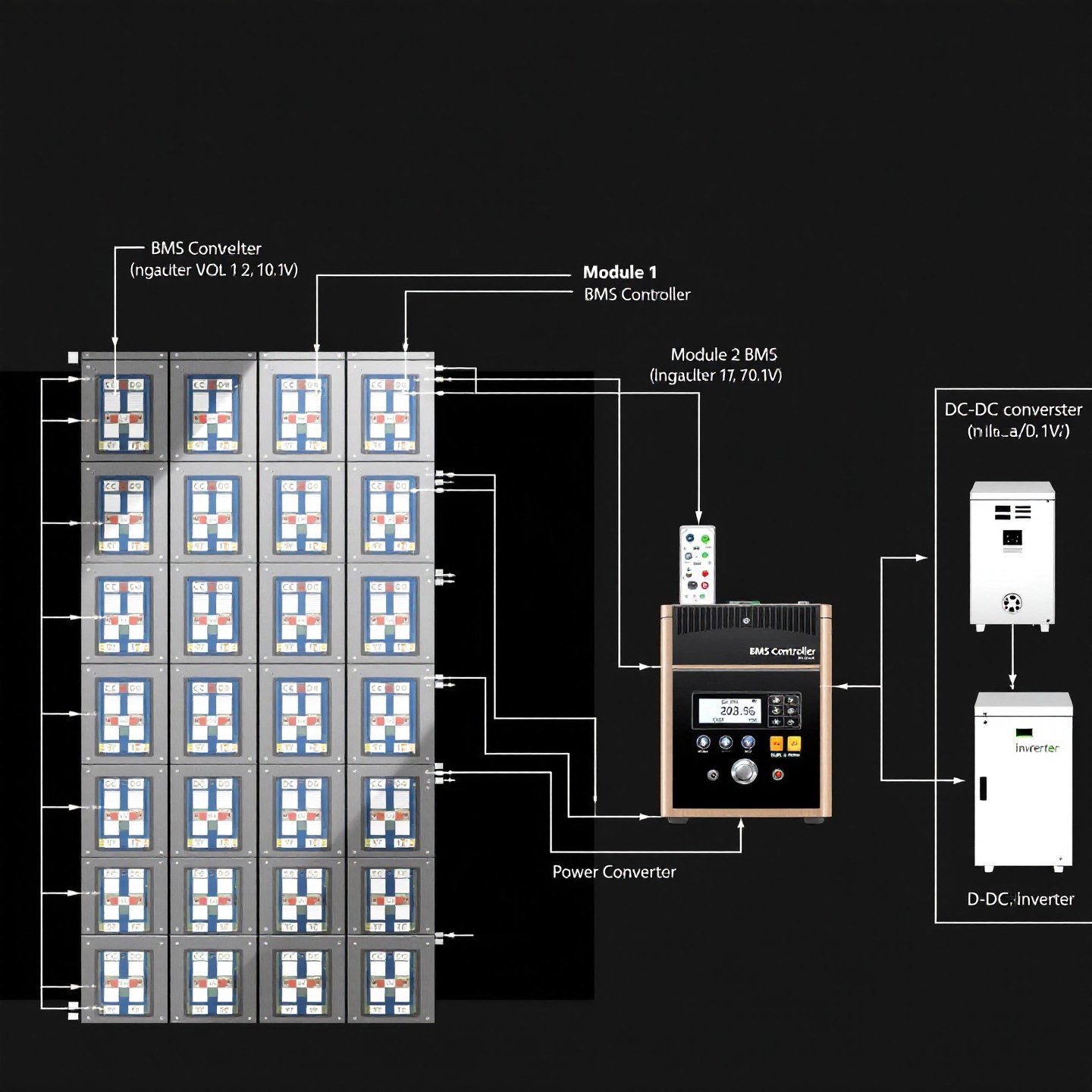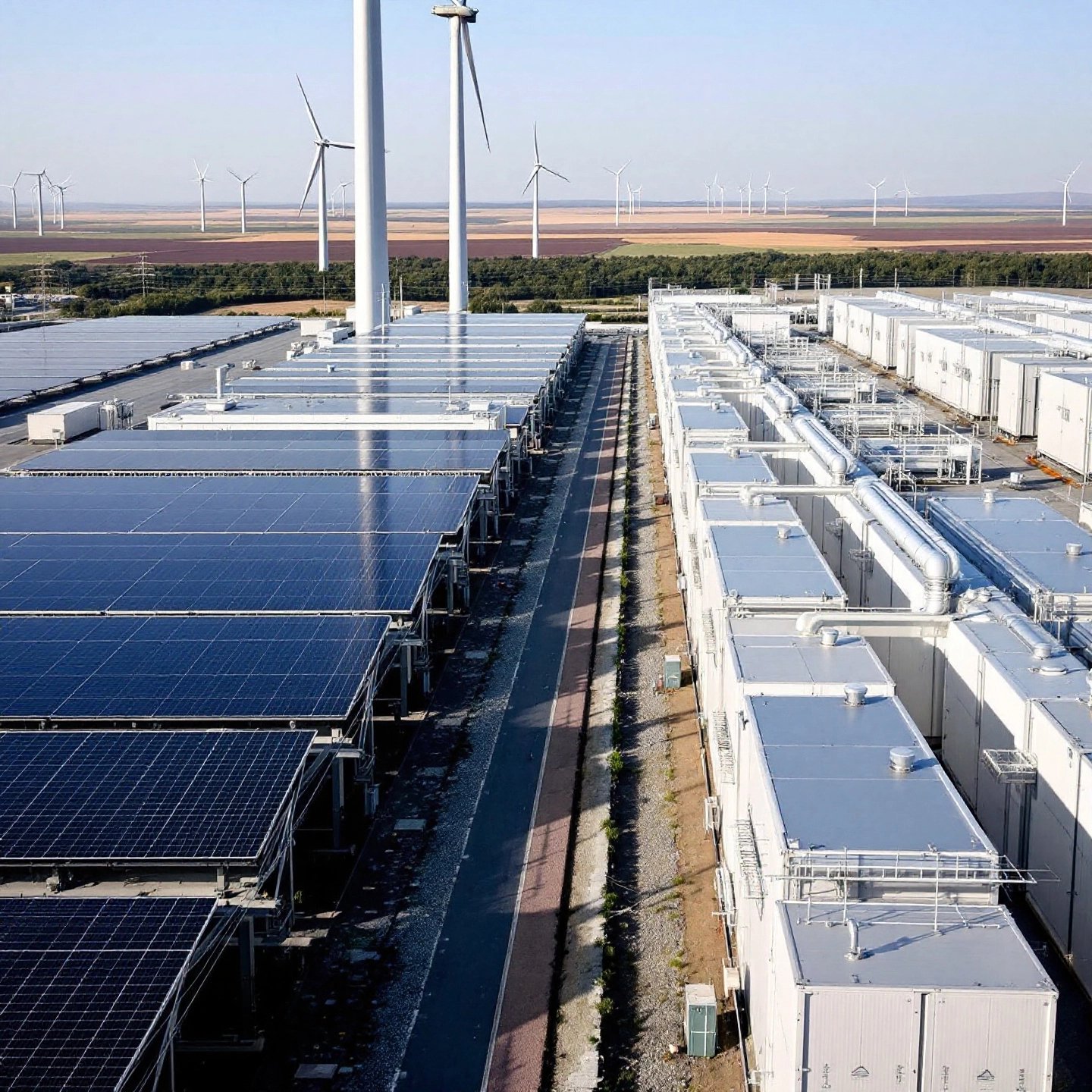Introduction to Battery Energy Storage Systems
In a world increasingly reliant on renewable energy, battery energy storage systems (BESS) have emerged as a pivotal technology in modern energy management. Imagine harnessing the power of the sun or the wind, storing it, and deploying it precisely when needed. Sounds complex? Not really! BESS are designed to store energy generated from renewable sources like solar and wind, ensuring a steady and reliable energy supply even when the sun isn’t shining or the wind isn’t blowing.
The significance of battery energy storage systems extends beyond just storing energy. They play a crucial role in balancing the supply and demand of electricity within the power grid. By storing excess energy generated during low-demand periods, BESS can provide backup power during peak demand times, ensuring a stable energy supply. This not only enhances the reliability of the grid but also reduces the dependency on fossil fuels, thus contributing to a greener planet.
Moreover, BESS are not just about energy storage; they’re about energy management. With advancements in technology, these systems are now equipped with intelligent software that uses algorithms to coordinate energy production and decide when to store or release energy to the grid. This sophisticated control ensures that energy is used efficiently, keeping costs down and maximizing the use of renewable resources.
As we delve deeper into this article, we’ll explore the various applications of BESS, the technologies that power them, and the considerations for their implementation. Whether you’re a homeowner looking to achieve energy independence or a business aiming for operational efficiency, understanding the fundamentals of BESS will empower you to make informed decisions about your energy future.
Understanding the Fundamentals of Battery Energy Storage Systems
At the core of every battery energy storage system (BESS) is a straightforward principle: store energy when it’s abundant and release it when it’s needed. But how exactly does this work? Imagine a rechargeable battery in your phone. You charge it when you have access to electricity, and it powers your device when you’re on the go. A BESS operates on the same fundamental charge and discharge cycles, albeit on a much larger scale.
BESS can store electricity from the grid, directly from power stations, or from renewable sources like solar panels. This stored energy is then available for use during peak demand periods or when renewable sources aren’t producing energy, such as at night or during calm weather. This flexibility is crucial for integrating renewable energy into the grid, ensuring a consistent power supply even when natural conditions are variable.
Impact of Battery Chemistries on BESS Performance
Different battery chemistries significantly influence the performance of a BESS. For instance, lithium-ion batteries are popular due to their high energy density and efficiency, making them ideal for both residential and commercial applications. However, alternatives like sodium-sulfur and iron-air batteries are emerging, each offering unique benefits and addressing specific challenges such as cost and sustainability (source).
Key Factors Influencing BESS Performance
- Capacity: The total amount of energy a BESS can store, often measured in kilowatt-hours (kWh).
- Depth of Discharge (DoD): Refers to the percentage of the battery that can be safely used without affecting its lifespan.
- Efficiency: The ratio of the energy output to the energy input, indicating how much energy is lost during the charge and discharge process.
These factors are crucial when evaluating a BESS for specific applications, as they determine the system’s suitability for different energy needs.
Integrating BESS with Other Energy Sources
A BESS can seamlessly integrate with other energy systems, such as solar panels, to enhance energy management. By storing excess solar energy produced during the day, a BESS can provide power during nighttime or cloudy days, effectively smoothing out the intermittent nature of renewable energy (source).
In summary, understanding the fundamentals of battery energy storage systems involves recognizing their operational principles, the impact of various battery chemistries, and the factors that influence their performance. As we continue, we’ll delve into the key components that make these systems effective and explore their diverse applications.

Key Components and Design Principles for Effective BESS
When you think of a battery energy storage system (BESS), imagine a sophisticated orchestra of components working in harmony to store and manage energy. The primary components of a BESS include battery modules, battery management systems (BMS), power conversion systems (PCS), and energy management systems (EMS). Each plays a critical role in ensuring the system’s efficiency and reliability.
Core Components of a BESS
- Battery Modules: These are the heart of the BESS, responsible for storing electrical energy in chemical form. The choice of battery technology, such as lithium-ion or flow batteries, significantly impacts factors like energy density, cycle life, and cost.
- Battery Management Systems (BMS): The BMS oversees the operation of the battery modules, ensuring optimal performance by monitoring cell voltages, temperatures, and preventing overcharging or deep discharging. This system is crucial for maintaining battery health and extending lifespan.
- Power Conversion Systems (PCS): PCS are responsible for converting the direct current (DC) stored in the batteries to alternating current (AC) for use in electrical systems, and vice versa. They ensure that energy flows efficiently between the battery and the grid or load.
- Energy Management Systems (EMS): Acting as the brain of the BESS, the EMS optimizes energy flow, manages charging and discharging cycles, and integrates with renewable energy sources to enhance overall system performance.
Design Parameters and Comparison
To better understand how different BESS configurations can meet specific needs, consider the following table comparing key design parameters across popular battery technologies:
| Battery Type | Voltage Range | Lifespan (Cycles) | Safety Features |
|---|---|---|---|
| Lithium-Ion | 3.6-4.2V per cell | 2000-5000 | Overcharge protection, thermal management |
| Flow Batteries | Varies (modular) | 10,000+ | Non-flammable, scalable capacity |
| Lead-Acid | 2V per cell | 500-1000 | Ventilation for gas release |
Scalability, Modularity, and Future Upgrades
One of the standout features of modern BESS design is scalability. Systems can be expanded by adding more battery modules, allowing for increased storage capacity as energy needs grow. This modularity not only enhances flexibility but also facilitates easier maintenance and upgrades.
Future upgrades in BESS technology are likely to focus on improving energy density, reducing costs, and integrating advanced management software to enhance efficiency. As technology evolves, systems are expected to become smarter, with AI-driven EMS that can predict energy demand and optimize storage strategies.
In conclusion, understanding the key components and design principles of a BESS is essential for selecting the right system for your needs. As we transition to the next section, we’ll explore the advantages and limitations of these systems, shedding light on their role in achieving energy efficiency and sustainability.
Exploring the Advantages and Limitations of Modern Solutions
Imagine having the ability to harness and store energy during the day to use at night, reducing your reliance on traditional power sources. This is precisely what a battery energy storage system (BESS) offers, providing numerous advantages that are reshaping how we think about energy use.
BESS Advantages
- Cost Savings: By storing energy when it is cheapest, BESS allows users to utilize stored power during peak periods when electricity prices are high. This “peak shaving” strategy can lead to substantial cost reductions on utility bills (source).
- Energy Independence: BESS empowers both residential and commercial users to rely less on the grid, enhancing energy autonomy. This is particularly beneficial for those with renewable energy systems, as it allows for the storage of excess solar or wind power for later use.
- Reduced Carbon Footprint: By decreasing dependency on fossil fuels and integrating more renewable energy into daily use, BESS plays a critical role in reducing greenhouse gas emissions. This not only benefits the environment but also aligns with global sustainability goals.
Battery Energy Storage Limitations
- High Upfront Costs: The initial investment for a BESS can be significant, particularly for large-scale installations. Although costs are decreasing over time, they can still be a barrier for some potential adopters.
- Temperature Sensitivity: BESS performance can be affected by extreme temperatures. High heat can lead to faster degradation of battery components, while cold can reduce efficiency. Advanced thermal management systems are often required to maintain optimal performance.
- Complex Management: Operating a BESS involves sophisticated control systems that require specialized knowledge for maintenance and management, adding to the complexity and potential costs of ownership.
Overcoming Challenges with Technological Advancements
Despite these limitations, ongoing research and technological advancements are steadily overcoming these challenges. For instance, improvements in battery chemistries, such as the development of solid-state and flow batteries, are enhancing durability and safety. Additionally, AI-driven management systems are optimizing performance and predicting maintenance needs, thus reducing operational complexities (source).
In summary, while BESS presents some challenges, the benefits they offer in terms of cost savings, energy independence, and environmental impact are substantial. As technology continues to advance, these systems are poised to become even more integral to sustainable energy solutions. As we move forward, let’s explore how these systems are being adopted in residential settings to further enhance energy management.

Residential Adoption and Home Energy Management Perspectives
Have you ever wondered how you could take more control over your home’s energy usage? Enter the world of home battery energy storage systems, which are becoming increasingly popular among homeowners looking to maximize their energy efficiency and autonomy. These systems, especially when integrated with rooftop solar setups, offer a myriad of benefits that extend beyond simple energy storage.
Integration with Rooftop Solar Setups
Imagine capturing the abundant energy of the sun during the day and utilizing it at night or during power outages. This is precisely what a solar battery energy storage system enables. By pairing solar panels with a home battery, you can store excess energy generated during sunny periods, ensuring a steady power supply even when the sun sets. This integration not only enhances energy independence but also provides a reliable backup power source during outages, offering peace of mind and continuity of daily activities.
Load Shifting and Energy Autonomy
One of the standout features of home battery energy storage is load shifting. This process allows homeowners to store energy when utility rates are low and use it during peak times when rates are higher, effectively reducing electricity bills. As utility companies increasingly adopt time-of-use pricing, this capability becomes invaluable. By strategically managing when energy is consumed, you can significantly lower your energy costs while also reducing strain on the grid during peak demand periods.
Enhancing Home Energy Management
Home battery systems are a crucial component of residential energy management systems (REMS), which optimize electricity consumption through smart devices and automation. These systems provide insights into energy usage patterns, helping homeowners make informed decisions about their energy consumption. By integrating with smart home devices, a REMS can automate energy-saving actions like adjusting HVAC settings or turning off lights when not in use, further enhancing efficiency and reducing environmental impact (source).
Choosing the Right Solar Panels
To fully realize the benefits of a home battery energy storage system, selecting the right solar panels is essential. Renewable Energy Nexus offers a wide range of solar panel options that can be tailored to meet your specific energy needs. Whether you’re looking for portable panels for flexibility or larger models for maximum efficiency, their selection ensures you’ll find the perfect fit for your home. For more information, visit their product page.
In conclusion, adopting a home battery energy storage system, especially in conjunction with a solar setup, provides significant advantages in terms of cost savings, energy independence, and environmental sustainability. As we explore further, you’ll discover how these systems are transforming not just homes, but also commercial and industrial energy landscapes.
Commercial and Industrial Growth in Battery Storage Applications
Imagine a bustling commercial district where businesses operate seamlessly, even during peak energy demand periods, thanks to the strategic implementation of commercial battery energy storage systems. These systems are pivotal in managing peak demand and enhancing operational efficiency, offering a competitive edge to businesses willing to invest in this transformative technology.
Peak Demand Management and Operational Efficiency
Commercial battery energy storage systems (BESS) are revolutionizing how businesses manage their energy consumption. By storing energy during off-peak times when electricity is cheaper and discharging it during peak periods, these systems help businesses avoid high demand charges, thus significantly reducing operational costs. This process, known as peak shaving, not only saves money but also alleviates pressure on the grid during high demand periods, contributing to overall grid stability.
Moreover, industrial battery storage systems enhance operational efficiency by providing a reliable backup power source. In industries where uninterrupted power is crucial, such as manufacturing and data centers, BESS ensures continuity, minimizing downtime and associated losses. These systems are becoming indispensable tools for industries aiming to enhance resilience and maintain productivity even during power outages (source).
Innovations and Trends in the Industry
The commercial and industrial sectors are witnessing a surge in innovations that are reshaping the landscape of battery energy storage. Companies are developing advanced software solutions for energy management, enabling businesses to optimize their energy use and integrate seamlessly with renewable energy sources. These innovations are crucial for co-optimizing applications like load shifting, renewable energy self-consumption, and participation in demand response programs.
Trends such as the integration of artificial intelligence (AI) in energy management systems are further enhancing the efficiency of BESS. AI-driven systems can predict energy demand patterns, optimize battery charging cycles, and even participate in virtual power plants (VPPs), where excess energy stored in batteries can be sold back to the grid. This not only provides a new revenue stream for businesses but also supports the transition to a more flexible and resilient energy grid (source).
Industrial Resilience and Power Outage Mitigation
Industrial battery storage systems play a critical role in enhancing the resilience of businesses against power outages. By providing a dependable source of backup power, these systems allow industries to maintain operations during grid failures, thus safeguarding against potential losses. Furthermore, as industries become increasingly reliant on digital technologies, the need for reliable power sources becomes even more critical, making BESS an essential component of modern industrial infrastructure.
In conclusion, commercial and industrial battery energy storage systems are not just about energy savings; they are about strategic energy management and resilience. As we move forward, these systems will continue to evolve, driven by technological advancements and an increasing emphasis on sustainability. Next, we’ll explore how large-scale deployments are integrating these systems at the grid level, paving the way for a more sustainable energy future.

Large Scale Deployment and Grid Level Integration Strategies
Imagine a world where renewable energy sources like wind and solar power are seamlessly integrated into our energy grid, providing a stable and reliable power supply. This vision is becoming a reality thanks to large scale battery energy storage systems (BESS), which are transforming the way utilities manage energy. These systems are crucial for stabilizing voltage and frequency on the grid, enabling a higher penetration of renewable energy sources.
The Role of Utility-Scale Battery Storage
Utility-scale battery storage, often referred to as grid scale battery storage systems, plays a pivotal role in modern energy infrastructure. These systems can store energy generated from renewable sources during periods of low demand and release it during peak demand, ensuring a consistent energy supply. This capability is essential for grid operators, as it helps balance supply and demand, reducing the need for fossil fuel-based peaking power plants, which are both costly and environmentally unfriendly.
Moreover, these systems provide critical grid services such as frequency response, capacity reserve, and ramp rate control. By offering these services, utility-scale BESS can defer investments in upgrading grid infrastructure, which can be a significant cost-saving measure for energy providers (source).
Enhancing Renewable Energy Integration
One of the greatest challenges with renewable energy is its intermittent nature. Solar and wind power generation can be unpredictable, leading to fluctuations in energy supply. Large scale battery energy storage systems address this issue by storing excess energy generated during peak production times and releasing it when production is low. This process, known as capacity firming, ensures that renewable energy can be relied upon even when natural conditions aren’t ideal.
By integrating with renewable energy sources, such as wind and solar, these systems allow for greater flexibility and reliability in the energy grid. They enable utilities to capture all the energy generated and release it as needed, smoothing out the variability associated with renewables (source).
Scalability and Future Prospects
Large scale battery storage solutions are highly scalable, allowing them to be deployed in various locations and sizes to meet specific grid needs. This flexibility is a significant advantage over traditional storage methods, such as pumped hydro storage, which require specific geographical conditions. As the demand for renewable energy grows, the scalability of battery storage will be critical in supporting the transition to a more sustainable energy grid.
Looking ahead, the continued development and deployment of these systems will be essential in achieving global energy goals. As technology advances, we can expect even greater efficiency and lower costs, making large scale battery energy storage an increasingly attractive option for utilities.
For more insights into utility-scale projects and how they are shaping the future of energy, Renewable Energy Nexus serves as a valuable resource, offering comprehensive information and guidance on the latest developments in this field.
Current Market Landscape and Emerging Technology Trends
Imagine a world where energy storage systems are as commonplace as smartphones, driving a clean energy revolution. This vision is rapidly materializing as the battery energy storage market experiences unprecedented growth. According to recent data, the global energy storage market nearly tripled in 2023, marking the largest year-on-year increase on record (source).
Driving Forces Behind Market Growth
Several factors are propelling this growth. Firstly, policy incentives and government mandates have played a crucial role. For instance, the Inflation Reduction Act in the U.S. and solar and wind co-location mandates in China have significantly boosted the market. These policies not only encourage the adoption of battery energy storage systems but also provide financial support that makes them more accessible to businesses and consumers.
Additionally, the cost of energy storage systems has plummeted, particularly in China, where prices fell by 43% in 2023 alone. This cost reduction is largely due to advancements in lithium iron phosphate (LFP) battery technology, which is less expensive and more sustainable compared to traditional nickel-based lithium-ion batteries.
Emerging Battery Technologies
The evolution of battery technology is another critical factor in the market’s expansion. Next-generation batteries, such as solid-state and flow batteries, are gaining traction due to their enhanced safety, longevity, and efficiency. Solid-state batteries, for example, eliminate the need for liquid electrolytes, reducing the risk of leakage and making them safer for widespread use (source).
Flow batteries, on the other hand, offer scalable energy storage solutions that are particularly suited for large-scale applications. They operate through reduction-oxidation reactions, which allow for more flexible and durable energy storage options. These technological advancements are not only driving down costs but also expanding the range of applications for battery energy storage systems.
Global Initiatives and Future Prospects
Globally, initiatives aimed at accelerating the adoption of battery energy storage are gaining momentum. Countries across Europe, Asia, and the Americas are implementing support schemes that promote the integration of renewable energy sources with storage technologies. These initiatives are crucial for meeting international climate goals and transitioning to a low-carbon economy.
Looking ahead, the battery energy storage market is poised for continued growth. BloombergNEF forecasts an annual growth rate of 21% through 2030, driven by expanding renewable energy markets and ongoing technological innovations. As the market evolves, the integration of AI and machine learning into energy management systems is expected to further enhance the efficiency and reliability of storage solutions.
In conclusion, the battery energy storage market is undergoing a transformative phase, characterized by rapid growth and technological advancements. As policies continue to support this expansion and emerging technologies unlock new possibilities, the future of energy storage looks promising, paving the way for a more sustainable and resilient energy landscape.
Practical Tips for Selecting and Maintaining the Right System
Choosing the right battery energy storage system (BESS) can seem daunting, but with the right approach, it becomes a manageable task. Here are some practical steps to guide you in selecting the perfect system for your needs:
Steps for Selecting a Suitable BESS
- Assess Capacity Needs: Determine the energy capacity you require by evaluating your typical energy consumption patterns and peak demand periods. Consider both your current needs and potential future expansions.
- Set a Budget: Establish a budget that accounts for not only the initial purchase but also installation and potential maintenance costs. Remember, while upfront costs might be high, long-term savings on energy bills can offset these expenses.
- Check Compatibility: Ensure the BESS is compatible with your existing energy systems, such as solar panels or grid connections. This includes verifying voltage and current requirements to avoid inefficiencies.
- Evaluate Warranty and Support: Look for systems that offer robust warranties and reliable customer support. A good warranty can safeguard your investment against potential defects or performance issues.
Maintenance Tips for Prolonging BESS Lifespan
- Regular Inspections: Conduct routine visual inspections to check for any signs of wear, damage, or corrosion. Ensure all connections are secure and free from debris or moisture (source).
- Adhere to Manufacturer Guidelines: Follow all maintenance and operation guidelines provided by the manufacturer. This includes optimal charging and discharging practices to prevent excessive wear on the batteries.
- Monitor Performance: Use the BESS’s management software to track efficiency, capacity, and internal resistance. Address any anomalies promptly to maintain optimal performance.
- Climate Control: Maintain appropriate environmental conditions, as extreme temperatures can affect battery performance. Ensure your system has adequate thermal management features.
Consulting Professionals
Finally, consider consulting certified installers or technicians when selecting and maintaining your BESS. Their expertise can help ensure that your system is installed correctly and operates efficiently, reducing the risk of costly errors and extending the system’s lifespan.
By following these steps and maintenance tips, you’ll be well-equipped to select and sustain a battery energy storage system that meets your needs, ensuring energy efficiency and reliability. As we conclude this article, let’s revisit the broader significance of BESS in shaping our energy future.
Conclusion
As we journey through the transformative landscape of battery energy storage systems (BESS), it becomes evident that these systems are not just a technological marvel but a cornerstone of our future energy resilience. Imagine a future where energy is not only abundant but efficiently managed, ensuring stability across homes, businesses, and entire grids. This vision is increasingly within reach, thanks to the strategic deployment of well-chosen BESS.
The significance of BESS lies in their ability to provide energy resiliency. By storing energy during periods of low demand and releasing it during peak times, BESS ensure a steady power supply, reducing reliance on traditional energy sources and enhancing grid stability. This capability is crucial as we transition towards a more sustainable energy paradigm, where renewable sources play a dominant role.
Innovation and Supportive Policies
Innovation is at the heart of the battery energy storage future. Advances in battery chemistries, such as solid-state and flow batteries, are enhancing the efficiency and safety of these systems. These innovations, coupled with intelligent energy management systems, are optimizing performance and paving the way for smarter energy solutions. Moreover, supportive policies and incentives are accelerating the adoption of BESS, making them more accessible and economically viable for a broader audience.
Governments and organizations worldwide are recognizing the potential of BESS and are implementing frameworks to support their integration into existing energy systems. These policies not only promote the use of renewable energy but also provide financial incentives that lower the barriers to entry for both businesses and consumers.
Considerations for Different Scales
When considering the adoption of a BESS, it’s essential to tailor the system to specific needs, whether for home, business, or utility scale. For homeowners, this might mean integrating a BESS with solar panels to achieve energy independence and cost savings. Businesses, on the other hand, may focus on operational efficiency and resilience against power outages. Utility-scale projects will aim to enhance grid stability and accommodate higher renewable energy penetration.
In conclusion, the future of battery energy storage is bright and full of potential. As innovation continues to drive advancements and supportive policies facilitate widespread adoption, BESS will undoubtedly play a pivotal role in shaping a sustainable and resilient energy future. By carefully considering specific requirements and leveraging the latest technologies, stakeholders at all levels can harness the full benefits of battery energy storage systems.
Frequently Asked Questions about Battery Energy Storage Systems
1. What is the battery energy storage system?
A battery energy storage system (BESS) stores energy from sources like solar and wind for use when needed, enhancing grid reliability and supporting renewable integration.
2. What is the disadvantage of a battery storage system?
Battery storage systems can have high upfront costs and may be sensitive to temperature changes, affecting performance and lifespan.
3. How does BESS make money?
BESS generates revenue through energy arbitrage, buying low-cost electricity and selling it during peak demand, and by participating in grid services.
4. How much does battery storage for a house cost?
Costs vary widely, from $20,000 to over $80,000, depending on the system size and whether it backs up critical loads or an entire home.
5. What are the benefits of integrating BESS with solar panels?
Integrating BESS with solar panels allows for energy independence, cost savings through load shifting, and reliable backup power during outages.



